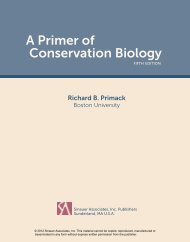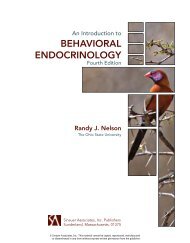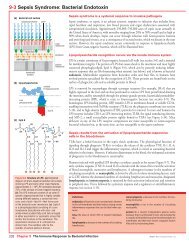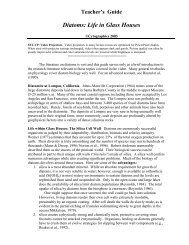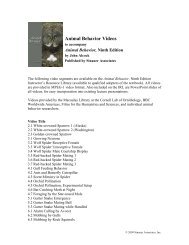Phylogenetic Trees Made Easy - Sinauer Associates
Phylogenetic Trees Made Easy - Sinauer Associates
Phylogenetic Trees Made Easy - Sinauer Associates
You also want an ePaper? Increase the reach of your titles
YUMPU automatically turns print PDFs into web optimized ePapers that Google loves.
<strong>Phylogenetic</strong> <strong>Trees</strong><br />
<strong>Made</strong> <strong>Easy</strong><br />
A How-To Manual<br />
Fourth Edition<br />
Barry G. Hall<br />
University of Rochester, Emeritus<br />
and<br />
Bellingham Research Institute<br />
<strong>Sinauer</strong> <strong>Associates</strong>, Inc. Publishers<br />
Sunderland, Massachusetts U.S.A.<br />
© <strong>Sinauer</strong> <strong>Associates</strong>, Inc. This material cannot be copied, reproduced, manufactured<br />
or disseminated in any form without express written permission from the publisher.
Table of Contents<br />
Chapter 1 • Read Me First! 1<br />
New and Improved Software 2<br />
Just What Is a <strong>Phylogenetic</strong> Tree? 3<br />
Estimating <strong>Phylogenetic</strong> <strong>Trees</strong>: The Basics 4<br />
Beyond the Basics 5<br />
Learn More about the Principles 6<br />
About Appendix III: F.A.Q. 7<br />
Computer Programs and Where to Obtain Them 7<br />
MEGA 5 8<br />
MrBayes 8<br />
FigTree 8<br />
Codeml 8<br />
SplitsTree and Dendroscope 8<br />
Utility Programs 8<br />
Text Editors 9<br />
Acknowledging Computer Programs 9<br />
The <strong>Phylogenetic</strong> <strong>Trees</strong> <strong>Made</strong> <strong>Easy</strong> Website 9<br />
Chapter 2 • Tutorial: Estimate a Tree 11<br />
Why Create <strong>Phylogenetic</strong> <strong>Trees</strong>? 11<br />
About this Tutorial 12<br />
Macintosh and Linux users 12<br />
A word about screen shots 12<br />
Search for Sequences Related to Your Sequence 13<br />
Decide Which Related Sequences to Include on Your Tree 16<br />
Establishing homology 17<br />
To include or not to include, that is the question 18<br />
© <strong>Sinauer</strong> <strong>Associates</strong>, Inc. This material cannot be copied, reproduced, manufactured<br />
or disseminated in any form without express written permission from the publisher.
x<br />
Table of Contents<br />
Download the Sequences 20<br />
Align the Sequences 23<br />
Make a Neighbor Joining Tree 24<br />
Summary 28<br />
Chapter 3 • Acquiring the Sequences 29<br />
Hunting Homologs: What Sequences Can Be Included on a Single Tree? 29<br />
Becoming More Familiar with BLAST 30<br />
BLAST help 32<br />
Using the Nucleotide BLAST Page 32<br />
Using BLAST to Search for Related Protein Sequences 34<br />
Finalizing Selected Sequences for a Tree 38<br />
Other Ways to Find Sequences of Interest (Beware! The Risks Are High) 43<br />
Chapter 4 • Aligning the Sequences 47<br />
Aligning Sequences with MUSCLE 47<br />
Examine and Possibly Manually Adjust the Alignment 51<br />
Trim excess sequence 51<br />
Eliminate duplicate sequences 54<br />
Check Average Identity to Estimate Reliability of the Alignment 56<br />
Codons: Pairwise amino acid identity 56<br />
Non-coding DNA sequences 57<br />
Increasing Alignment Speed by Adjusting MUSCLE’s Parameter Settings 58<br />
How MUSCLE works 58<br />
Adjusting parameters to increase alignment speed 59<br />
Aligning Sequences with ClustalW 60<br />
Chapter 5 • Major Methods for Estimating <strong>Phylogenetic</strong><br />
<strong>Trees</strong> 61<br />
Learn More about Tree-Searching Methods 62<br />
Distance versus Character-Based Methods 64<br />
Learn More about Distance Methods 64<br />
Which Method Should You Use? 66<br />
Accuracy 66<br />
Ease of interpretation 67<br />
Time and convenience 67<br />
© <strong>Sinauer</strong> <strong>Associates</strong>, Inc. This material cannot be copied, reproduced, manufactured<br />
or disseminated in any form without express written permission from the publisher.
Table of Contents<br />
xi<br />
Chapter 6 • Neighbor Joining <strong>Trees</strong> 69<br />
Using MEGA 5 to Estimate a Neighbor Joining Tree 69<br />
Learn More about <strong>Phylogenetic</strong> <strong>Trees</strong> 70<br />
Determine the suitability of the data for a Neighbor Joining tree 73<br />
Estimate the tree 74<br />
Learn More about Evolutionary Models 75<br />
Unrooted and Rooted trees 80<br />
Estimating the Reliability of a Tree 82<br />
Learn More about Estimating the Reliability of <strong>Phylogenetic</strong> <strong>Trees</strong> 83<br />
What about Protein Sequences? 89<br />
Chapter 7 • Drawing <strong>Phylogenetic</strong> <strong>Trees</strong> 91<br />
Changing the Appearance of a Tree 92<br />
The Options dialog 94<br />
Branch styles 96<br />
Fine-tuning the appearance of a tree 99<br />
Subtrees 102<br />
Rooting a Tree 106<br />
Finding an outgroup 108<br />
Saving <strong>Trees</strong> 108<br />
Saving a tree description 108<br />
Saving a tree image 108<br />
Captions 109<br />
Chapter 8 • Parsimony 111<br />
Learn More about Parsimony 111<br />
MP Search Methods 113<br />
Multiple Equally Parsimonious <strong>Trees</strong> 116<br />
Calculating branch lengths 117<br />
Consensus and bootstrap trees 118<br />
In the Final Analysis 122<br />
Chapter 9 • Maximum Likelihood 123<br />
Learn More about Maximum Likelihood 123<br />
ML Analysis Using MEGA 125<br />
Test alternative models 126<br />
Rooting the ML tree 129<br />
© <strong>Sinauer</strong> <strong>Associates</strong>, Inc. This material cannot be copied, reproduced, manufactured<br />
or disseminated in any form without express written permission from the publisher.
xii<br />
Table of Contents<br />
The special case of zero length branches 132<br />
Estimating the Reliability of an ML Tree by Bootstrapping 134<br />
What about Protein Sequences? 137<br />
Chapter 10 • Bayesian Inference of <strong>Trees</strong> Using<br />
MrBayes 139<br />
MrBayes: An Overview 139<br />
Learn More about Bayesian Inference 141<br />
Saving time (and perhaps your sanity) 142<br />
Choose a model 143<br />
A General Strategy for Estimating <strong>Trees</strong> Using MrBayes 143<br />
Creating the Execution File 144<br />
What the statements in the example mrbayes block do 145<br />
How the stoprule option of the mcmc command is implemented 148<br />
How Do You Run a MrBayes Analysis? 148<br />
More Complex (and More Useful) MrBayes Blocks 149<br />
Including a user tree 149<br />
The nperts option of the mcmc command 150<br />
Coding sequences and the charset statement 150<br />
The Screen Output while MrBayes Is Running 151<br />
What If You Don’t Get Convergence? 152<br />
What about Protein Sequences? 156<br />
Visualizing the MrBayes Tree 156<br />
Using FigTree 158<br />
The side panel 158<br />
The icons above the tree 160<br />
Chapter 11 • Working with Various Computer<br />
Platforms 161<br />
Command Line Programs 161<br />
MEGA on the Macintosh Platform 162<br />
Navigating among folders on the Mac 162<br />
Printing trees and text from MEGA 165<br />
The Line Endings Issue 165<br />
Installing Command Line Programs 165<br />
Macintosh and Linux: Use the bin folder 166<br />
Windows: Create a bin folder and a path to it 166<br />
Command Line Programs: The Running Environment 168<br />
© <strong>Sinauer</strong> <strong>Associates</strong>, Inc. This material cannot be copied, reproduced, manufactured<br />
or disseminated in any form without express written permission from the publisher.
Table of Contents<br />
xiii<br />
Windows: A brief visit to the Command Prompt program 168<br />
Macintosh and Linux: A brief visit to Terminal and Unix 170<br />
Acquiring and Installing MrBayes 172<br />
Windows users 172<br />
Macintosh and Linux users 173<br />
Compile MrBayes for your Mac 173<br />
Running the Utility Programs 174<br />
Utility programs for Windows 175<br />
Utility programs for Macintosh and Linux 175<br />
Chapter 12 • Advanced Alignment Using GUIDANCE 177<br />
Issues of Alignment Reliability 177<br />
Unreliable sequences 177<br />
Unreliable regions 178<br />
How GUIDANCE Works 178<br />
An Example Illustrated by the SmallData Data Set 179<br />
Make a file of the unaligned sequences in FASTA format 180<br />
Starting the run 180<br />
Viewing the results 182<br />
Eliminate unreliable sequences 186<br />
Applications of GUIDANCE 190<br />
Chapter 13 • Reconstructing Ancestral Sequences 191<br />
Using MEGA to Estimate Ancestral Sequences by Maximum Likelihood 192<br />
Create the alignment 192<br />
Construct the phylogeny 193<br />
Examine the ancestral states at each site in the alignment 194<br />
Estimate the ancestral sequence 196<br />
Calculating the ancestral protein sequence and amino acid probabilities 201<br />
How Accurate are the Estimated Ancestral Sequences? 201<br />
Chapter 14 • Detecting Adaptive Evolution 203<br />
Effect of Alignment Accuracy on Detecting Adaptive Evolution 205<br />
Using MEGA to Detect Adaptive Evolution 205<br />
Detecting overall selection 205<br />
Detecting selection between pairs 206<br />
Finding the region of the gene that has been subject to positive selection 208<br />
Using Codeml to Detect Adaptive Evolution 211<br />
Installation 211<br />
© <strong>Sinauer</strong> <strong>Associates</strong>, Inc. This material cannot be copied, reproduced, manufactured<br />
or disseminated in any form without express written permission from the publisher.
xiv<br />
Table of Contents<br />
The files you need to run codeml 211<br />
Questions that underlie the models 213<br />
Run codeml 214<br />
Identify the branches along which selection may have occurred 214<br />
Test the statistical significance of the dN/dS ratios 216<br />
Summary 218<br />
Chapter 15 • <strong>Phylogenetic</strong> Networks 219<br />
Why <strong>Trees</strong> Are Not Always Sufficient 219<br />
Unrooted and Rooted <strong>Phylogenetic</strong> Networks 221<br />
Using SplitsTree to Estimate Unrooted <strong>Phylogenetic</strong> Networks 221<br />
Estimating networks from alignments 221<br />
Learn More about <strong>Phylogenetic</strong> Networks 223<br />
Rooting an unrooted network 234<br />
Estimating networks from trees 235<br />
Consensus networks 236<br />
Supernetworks 241<br />
Using Dendroscope to Estimate Rooted Networks from<br />
Rooted <strong>Trees</strong> 243<br />
Chapter 16 • Some Final Advice: Learn to Program 249<br />
Appendix I • File Formats and Their Interconversion 251<br />
Format Descriptions 251<br />
The MEGA format 251<br />
The FASTA format 252<br />
The Nexus format 253<br />
The PHYLIP format 256<br />
Interconverting Formats 257<br />
FastaConvert and MEGA 257<br />
Other format conversion programs 257<br />
Appendix II • Additional Programs 259<br />
Appendix III • Frequently Asked Questions 263<br />
Literature Cited 267<br />
Index to Major Program Discussions 269<br />
Subject Index 275<br />
© <strong>Sinauer</strong> <strong>Associates</strong>, Inc. This material cannot be copied, reproduced, manufactured<br />
or disseminated in any form without express written permission from the publisher.




